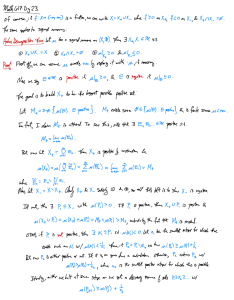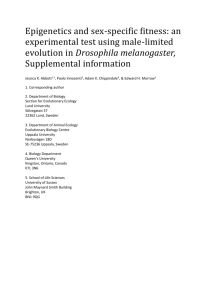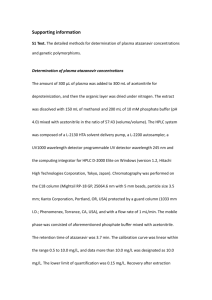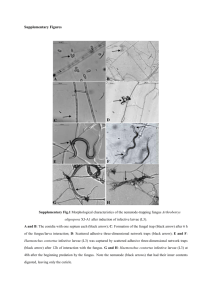Document 13308673
advertisement
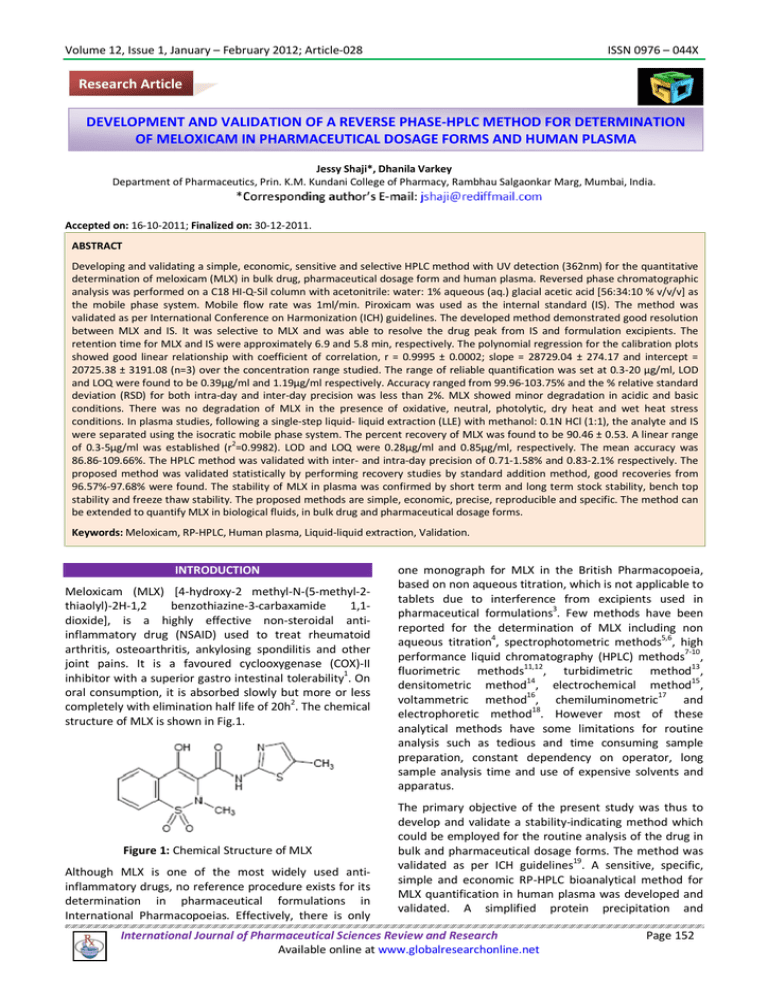
Volume 12, Issue 1, January – February 2012; Article-028
ISSN 0976 – 044X
Research Article
DEVELOPMENT AND VALIDATION OF A REVERSE PHASE-HPLC METHOD FOR DETERMINATION
OF MELOXICAM IN PHARMACEUTICAL DOSAGE FORMS AND HUMAN PLASMA
Jessy Shaji*, Dhanila Varkey
Department of Pharmaceutics, Prin. K.M. Kundani College of Pharmacy, Rambhau Salgaonkar Marg, Mumbai, India.
Accepted on: 16-10-2011; Finalized on: 30-12-2011.
ABSTRACT
Developing and validating a simple, economic, sensitive and selective HPLC method with UV detection (362nm) for the quantitative
determination of meloxicam (MLX) in bulk drug, pharmaceutical dosage form and human plasma. Reversed phase chromatographic
analysis was performed on a C18 HI-Q-Sil column with acetonitrile: water: 1% aqueous (aq.) glacial acetic acid [56:34:10 % v/v/v] as
the mobile phase system. Mobile flow rate was 1ml/min. Piroxicam was used as the internal standard (IS). The method was
validated as per International Conference on Harmonization (ICH) guidelines. The developed method demonstrated good resolution
between MLX and IS. It was selective to MLX and was able to resolve the drug peak from IS and formulation excipients. The
retention time for MLX and IS were approximately 6.9 and 5.8 min, respectively. The polynomial regression for the calibration plots
showed good linear relationship with coefficient of correlation, r = 0.9995 ± 0.0002; slope = 28729.04 ± 274.17 and intercept =
20725.38 ± 3191.08 (n=3) over the concentration range studied. The range of reliable quantification was set at 0.3-20 µg/ml, LOD
and LOQ were found to be 0.39µg/ml and 1.19µg/ml respectively. Accuracy ranged from 99.96-103.75% and the % relative standard
deviation (RSD) for both intra-day and inter-day precision was less than 2%. MLX showed minor degradation in acidic and basic
conditions. There was no degradation of MLX in the presence of oxidative, neutral, photolytic, dry heat and wet heat stress
conditions. In plasma studies, following a single-step liquid- liquid extraction (LLE) with methanol: 0.1N HCl (1:1), the analyte and IS
were separated using the isocratic mobile phase system. The percent recovery of MLX was found to be 90.46 ± 0.53. A linear range
2
of 0.3-5µg/ml was established (r =0.9982). LOD and LOQ were 0.28µg/ml and 0.85µg/ml, respectively. The mean accuracy was
86.86-109.66%. The HPLC method was validated with inter- and intra-day precision of 0.71-1.58% and 0.83-2.1% respectively. The
proposed method was validated statistically by performing recovery studies by standard addition method, good recoveries from
96.57%-97.68% were found. The stability of MLX in plasma was confirmed by short term and long term stock stability, bench top
stability and freeze thaw stability. The proposed methods are simple, economic, precise, reproducible and specific. The method can
be extended to quantify MLX in biological fluids, in bulk drug and pharmaceutical dosage forms.
Keywords: Meloxicam, RP-HPLC, Human plasma, Liquid-liquid extraction, Validation.
INTRODUCTION
Meloxicam (MLX) [4-hydroxy-2 methyl-N-(5-methyl-2thiaolyl)-2H-1,2
benzothiazine-3-carbaxamide
1,1dioxide], is a highly effective non-steroidal antiinflammatory drug (NSAID) used to treat rheumatoid
arthritis, osteoarthritis, ankylosing spondilitis and other
joint pains. It is a favoured cyclooxygenase (COX)-II
inhibitor with a superior gastro intestinal tolerability1. On
oral consumption, it is absorbed slowly but more or less
completely with elimination half life of 20h2. The chemical
structure of MLX is shown in Fig.1.
Figure 1: Chemical Structure of MLX
Although MLX is one of the most widely used antiinflammatory drugs, no reference procedure exists for its
determination in pharmaceutical formulations in
International Pharmacopoeias. Effectively, there is only
one monograph for MLX in the British Pharmacopoeia,
based on non aqueous titration, which is not applicable to
tablets due to interference from excipients used in
pharmaceutical formulations3. Few methods have been
reported for the determination of MLX including non
aqueous titration4, spectrophotometric methods5,6, high
performance liquid chromatography (HPLC) methods7-10,
fluorimetric methods11,12, turbidimetric method13,
densitometric method14, electrochemical method15,
voltammetric method16, chemiluminometric17 and
electrophoretic method18. However most of these
analytical methods have some limitations for routine
analysis such as tedious and time consuming sample
preparation, constant dependency on operator, long
sample analysis time and use of expensive solvents and
apparatus.
The primary objective of the present study was thus to
develop and validate a stability-indicating method which
could be employed for the routine analysis of the drug in
bulk and pharmaceutical dosage forms. The method was
validated as per ICH guidelines19. A sensitive, specific,
simple and economic RP-HPLC bioanalytical method for
MLX quantification in human plasma was developed and
validated. A simplified protein precipitation and
International Journal of Pharmaceutical Sciences Review and Research
Available online at www.globalresearchonline.net
Page 152
Volume 12, Issue 1, January – February 2012; Article-028
extraction procedure was selected for extraction of MLX
from the chosen biological matrix. Minimized sample
handling and chromatographic run times provided fast
quantitative results while maintaining the specificity,
accuracy and precision required for the quantification of
MLX.
MATERIALS AND METHODS
Reagents and chemicals
Pharmaceutical grade of MLX was obtained as a gift
sample from Zest Pharma Indore, India (Batch No.
ALC/MLX/090302). It was certified to contain 99.78% w/w
(on dried basis) and was used without further
purification. The internal standard (IS) for MLX, piroxicam
was obtained from Cipla Ltd., Mumbai, India (Batch No.
PX 07/0708). HPLC grade LiChrosolv acetonitrile and
methanol was from Merck Specialities Pvt. Ltd., Mumbai,
India. Glacial acetic acid HPLC grade was obtained from
Thermo Fisher Scientific India Pvt. Ltd. (Qualigens),
Mumbai, India. Water of HPLC and Spectroscopic grade
(J.K. labs, Mumbai, India) was used throughout the study.
All other chemicals used were of analytical reagent grade.
Commercial pharmaceutical preparation Muvera 15® (Sun
Pharma, Sikkim) containing MLX 15mg was purchased
from local pharmacy. Fresh frozen human plasma B.P.
was obtained from Ashirwad Blood Bank, Mumbai and
stored at -20oC until analysis. Prior to the study the
plasma was thawed at room temperature (30-37 oC).
Chromatographic conditions
The system comprised of a Jasco PU-2080 Plus HPLC
Pump equipped with Jasco-2075 Plus UV/Vis Detector, LCNet II ADC as the chromatography interface and a
rheodyne injector with a 20-µl loop. Data integration was
done using Borwin software package V 1.50. Specificity
studies were conducted on Jasco PU-2080 Plus Intelligent
HPLC Pump equipped with Jasco MD-2010 Plus multi
wavelength detector (Photo Diode Array Detector), Jasco
LC-Net II ADC as the chromatography interface and a
rheodyne injector with a 20-µl loop. Data integration was
done using Chrompass V. 2.1. In addition electronic
balance (Mettler Toledo), microlitre syringe (Hamilton,
100 µl), micropipette (Labline Eco, 10-100 µl),
refrigerated cooling centrifuge RC 4100 D (Eltek,
Electrocraft India Pvt. Ltd., Mumbai), Cyclomixer (Remi
Equipment Pvt. Ltd., Mumbai) and micropore filtration
assembly was used in this study.
The separation of compounds was made on a HI-Q-Sil C18
column (4.6mm x 250mm, 5µm particle size) (Kya Tech
Corporation, Japan). Detection was set at wavelength of
362nm. The mobile phase composed of acetonitrile:
water: 1% aq. glacial acetic acid (56:34:10 % v/v/v,)
pumped at a flow rate of 1ml/min. The mobile phase was
filtered through a 0.45µ pore size membrane filter
(Sartorius, Germany) and degassed ultrasonically after
mixing. The run time was set at 10 min with the HPLC
system operating at room temperature.
ISSN 0976 – 044X
Preparation of stock solutions and working standard
solution
Standard stock solution of MLX (100 µg/ml) and IS (100
µg/ml) were prepared in methanol. The working
standards were obtained by diluting the standard stock
solutions with methanol. MLX concentration in the
working standard solutions chosen for the calibration
curves were 0.3, 0.5, 1, 2, 3, 5, 10, 15 and 20µg/ml
containing IS (10µg/ml). In plasma studies, the working
standard solutions of MLX were produced by diluting the
standard stock solutions with blank human plasma. The
six calibration standards of MLX (concentrations: 0.3, 0.5,
1, 3, 5 µg/ml) were prepared independently. The working
IS solution (10µg/ml) was prepared by diluting stock with
methanol. The procedure for analysis followed is
described earlier under the subsection, ‘Chromatographic
conditions’.
Extraction procedure
MLX solutions and the IS were added to blank plasma
samples in a glass tube. Protein precipitation and
extraction was carried out by a single-step liquid-liquid
extraction (LLE) method. Extraction solvents methanol:
0.1N HCl (1:1 ratio, pH 2.60±0.02) was added to the
tubes. The mixture was vortexed for 30 sec. The resultant
was centrifuged at -20oC, 5000 rpm for 5min. The
supernatant was gently removed with micro-pipette and
transferred to HPLC vials. The supernatants obtained
were suitably diluted with the mobile phase and
subsequently injected into the column for HPLC analysis.
Method development
Initial trial experiments were performed to select a
suitable solvent system for estimation of MLX, and to
attain good resolution between MLX, IS and the
degradation products. The sensitivity of the assay,
suitability for stability studies, time required for the
analysis, ease of preparation, and use of readily available
cost-effective solvents were the decisive factors for the
suitability of mobile phase. Various mobile phase systems
tried included: methanol: water (70:30, % v/v),
acetonitrile: water (70:30, % v/v), methanol: water: acetic
acid (55:45:5% v/v), methanol: water: glacial acetic acid
(80:19.9:0.1, % v/v/v), methanol: water: 5 % aq. glacial
acetic acid (56:34:10, % v/v/v), methanol: water: 0.2M
disodium hydrogen phosphate (65:34:1, % v/v/v),
methanol: acetonitrile: water: glacial acetic acid
(40:40:19.9:0.1, % v/v/v/v), acetonitrile: water: glacial
acetic acid (80:19.9:0.1, % v/v/v), acetonitrile: methanol:
glacial acetic acid (80:19.9:0.1, % v/v/v), acetonitrile:
methanol: 1 % aq. glacial acetic acid (56:34:10, % v/v/v),
acetonitrile: water: 1 % aq. glacial acetic acid (50:30:20, %
v/v/v) and acetonitrile: water: 1 % aq. glacial acetic acid
(60:20:20, % v/v/v). A mobile phase system comprising of
acetonitrile: water: 1% aqueous (aq.) glacial acetic acid
(56:34:10, % v/v/v) was found to be optimum.
International Journal of Pharmaceutical Sciences Review and Research
Available online at www.globalresearchonline.net
Page 153
Volume 12, Issue 1, January – February 2012; Article-028
Validation of method: quantitation of MLX in bulk and
pharmaceutical dosage form
ISSN 0976 – 044X
Accuracy
The proposed method was validated in compliance with
ICH Guidelines. The method was validated for linearity
and range, limit of detection (LOD), limit of quantitation
(LOQ), precision, specificity, accuracy, repeatability and
robustness.
Recovery studies by the standard addition method (n=2)
were performed. Previously analyzed samples of MLX (6
µg/ml) were spiked with 50, 100, and 150% extra MLX
standard and the mixtures were analyzed by the
proposed method. Recovery (%) was calculated for each
concentration.
Linearity
Robustness
A calibration curve of MLX was constructed in the
concentration range of 0.3, 0.5, 1, 2, 3, 5, 10, 15 and
20µg/ml containing IS (10µg/ml) to establish linearity of
the proposed method. The linearity plot was obtained by
plotting peak area against corresponding concentrations
of MLX. Linear regression analysis was employed to
calculate the regression equations and the correlation
coefficients.
Robustness was determined by change in mobile phase
composition (± 1 ml organic phase concentration) and
flow rate (± 0.1 min).
Limit of detection and limit of quantification
Based on the standard deviation of the response and the
slope, LOD and LOQ were estimated using the formulae:
LOD= 3.3 σ/S
Where σ = the standard deviation of the response, S = the
slope of the calibration curve
LOQ = 10 σ/S
Where σ = the standard deviation of the response, S = the
slope of the calibration curve
LOD and LOQ were determined from the standard
deviations of the responses for six replicate
determinations.
Repeatability
Injection repeatability: Six injections of 10 µg/ml solution
of MLX were analyzed and % RSD was calculated for
injection repeatability.
Precision
Precision is a measure of the reproducibility of the
analytical method under normal operating conditions.
Precision is expressed as relative standard deviation (%
RSD).
1.
Intra-day variation: Measurement of intra-day
variation of MLX solutions at three different
concentrations (1, 10 and 15 µg/ml) was carried out
by injecting the samples on the same day at
different time intervals (n=3).
2.
Analysis repeatability: It was obtained by
determining the RSD of replicate samples (n=3) of
the accuracy study.
3.
Intermediate precision (Inter-day variation):
Measurement of inter-day variation of MLX
solutions at three different concentrations (1, 10
and 15 µg/ml) in triplicate on three consecutive
days determined the intermediate precision.
Sample solution stability
The stability of the drug in solution during analysis were
determined by repeated analysis of samples during the
course of experimentation on the same day and also after
storage of the drug solution for 72 h under laboratory
bench conditions (25±2°C) and under refrigeration
(8±1°C).
Specificity/Selectivity
The specificity of the method was determined by
exposing the sample solution (1mg/ml) to acidic (1N HCl),
basic (1N NaOH), neutral and oxidizing (30% H2O2), stress
conditions. The samples were refluxed for 6 h at 60oC,
filtered, suitably diluted and analyzed. MLX was stored in
oven at 50oC for 72h to study dry heat degradation and
for wet degradation MLX was stored at 50oC and 75%
relative humidity for 3 months. The photochemical
stability of the drug was studied by exposing the stock
solution to direct sunlight for 7 days.
System suitability tests
The chromatographic systems used for analysis must pass
the system suitability limits before sample analysis can
commence. Injection repeatability, precision, tailing
factor (T), theoretical plate number (N) and resolution
(Rs) for the principal peak, internal standard and its
degradation product were the parameters tested on a 10
µg/ml sample of MLX to assist the accuracy and precision
of the developed HPLC method.
Analysis of MLX in marketed tablets (Assay)
Twenty tablets (strength: 15 mg/tablet) were crushed and
triturated well in a mortar. A powder sample, equivalent
to 15mg of MLX, was accurately weighed and transferred
to a 25ml volumetric flask. The drug was extracted into
methanol and mixed thoroughly for 10 min using a
sonicator. The solution was filtered through 0.45 micron
pore filter after making up the volume, adequately
diluted with mobile phase and analyzed by the proposed
HPLC method. The possibility of interference of excipients
with the analysis was studied.
International Journal of Pharmaceutical Sciences Review and Research
Available online at www.globalresearchonline.net
Page 154
Volume 12, Issue 1, January – February 2012; Article-028
Bioanalytical method development and validation
Calibration curve, LOD and LOQ
The calibration samples were prepared by spiking 1ml of
blank plasma with various concentrations of MLX. The
extraction was done as per the method described earlier
in section “extraction procedure’’. The supernatants
obtained were suitably diluted with mobile phase to
attain a concentration range of 0.3-5 µg/ml in plasma. 20
µl of the samples were injected and peak area was
obtained. A calibration curve was constructed by plotting
peak areas versus concentrations. All solutions were
stored at 4oC and protected from light. Correlation
2
coefficient (r ) and % CV of the regression line of the
standards were used to evaluate linearity, accuracy and
precision. A generally accepted CV or 15% of the nominal
concentration was taken as the acceptance criteria as per
the guidelines by FDA.
A blank sample (matrix sample processed without internal
standard), a zero sample (matrix sample processed with
internal standard), and six non-zero samples covering the
expected range, including LOQ was analyzed for
calibration studies.
LOD and LOQ were based on the standard deviation of
the response and the slope of the corresponding curve.
The acceptance criterion for each back calculated
standard concentration was 15% deviation from the
nominal value except LLOQ, which was set at 20%. The
deviation of the mean from the true value serves as the
measure of accuracy.
Determination of accuracy, precision and recovery
The precision of the method was determined by intra-day
and intermediate precision (inter-day). 3 concentrations
{low concentration (LC), intermediate concentration (IC)
and higher concentration (HC) - 1µg/ml, 3µg/ml and
5µg/ml respectively} were measured three times in a day
and the same were measured in next three consecutive
days. The % CV was calculated.
Accuracy was measured using a minimum of five
determinations per concentration (1µg/ml, 3µg/ml and
5µg/ml).
The recovery of an analyte in an assay is the detector
response obtained from an amount of the analyte added
to and extracted from the biological matrix, compared to
the detector response obtained for the true
concentration of the pure authentic standard. Recovery
pertains to the extraction efficiency of an analytical
method within the limits of variability. Recovery of MLX
(n=5) was evaluated by comparing the mean peak areas
of five extracted low, medium and high samples (8µg/ml,
10µg/ml and 12µg/ml)
to mean peak areas of
unprocessed standards that represent 100% recovery.
Specificity and selectivity
Randomly selected six blank human plasma samples,
carried through the extraction procedure were
ISSN 0976 – 044X
chromatographed to determine the interference from
endogenous matrix compounds. Chromatograms of
plasma were examined for potential interfering
substances that may co-elute with MLX.
Stability studies
The stability of MLX solutions was assessed in analytical
standard solutions, processed sample extracts and
biological matrix by comparison to freshly spiked plasma
samples.
1.
Short term stock stability: A stock solution of MLX
and IS was kept at room temperature for 8 hours.
2.
Long term stock stability: A stock solution of MLX
and IS was kept at room temperature for 45 days.
3.
Bench top stability: The replicate concentrations of
low and high standard samples were determined by
comparing the mean area ratio of freshly thawed
samples with samples kept at room temperature for
6 hours.
4.
Freeze thaw stability: The stability of low and high
standard samples was determined after three freeze
thaw cycles, by thawing at room temperature for 23 h, refrozen for 12-24 h. The concentration of MLX
was determined and % CV was calculated.
RESULTS AND DISCUSSION
Optimization of extraction solvent
MLX binds significantly to plasma proteins, thus it is
necessary to extract it and then ensure that all MLX is
quantified. Prior to HPLC analysis, several common
protein precipitating solvents and their combinations
were tested to determine the composition for optimal
MLX recovery from the biological matrix. Each solvent or
mixture was added in a 1:1 ratio into blank plasma
samples spiked with equal amounts of MLX and IS and
subjected to similar sample preparation procedure as
described previously. The supernatants were suitably
diluted with mobile phase and injected into the column.
The MLX peak in chromatogram was evaluated in terms
of height, broadness of peak base, symmetry and
recovery. The composition of the extraction solvent that
produced the highest, narrowest peak base and most
symmetrical peak was selected. The extraction solvent
composition which gave highest extraction efficiency was
selected for method validation. Extraction efficiency of
MLX from plasma using various extraction solvents is
shown in Table 1. Combination of 0.1N HCl and methanol
was found to be a good extracting solvent and produced a
satisfactory chromatogram. It was observed that pH of
the solvent used for sample processing and preparation
of stock and standard affected the shape of the
chromatogram peak and RT of the analyte. MLX has two
pKa values and the MLX profile was most likely to be
affected by the pH of the environment and thus the
extent of ionization of MLX molecules. Therefore it was
concluded that low pH would be more suitable for
construction of MLX solutions.
International Journal of Pharmaceutical Sciences Review and Research
Available online at www.globalresearchonline.net
Page 155
Volume 12, Issue 1, January – February 2012; Article-028
ISSN 0976 – 044X
Table 1: Extraction efficiency of MLX from different
solvent compositions
Ratio
Extraction
Efficiency
(%) ± SD
Ethyl acetate
Acetonitrile
Methanol
0.1 N HCl and ethyl acetate
1:1
62.06 ± 1.42
72 ± 1.97
88.31 ± 0.58
68.61 ± 2.34
0.1 N HCl and methanol
0.1 N HCl and acetonitrile
Perchloric acid 70% and methanol
Perchloric acid 70% and ethyl acetate
1:1
1:1
1:1
1:1
90.46 ± 0.53
24.78 ± 0.82
57.53 ± 1.66
65.67 ± 5.09
Extraction solvent/composition
Chromatographic separation
The composition of mobile phase was optimized through
several trials to achieve good resolution and symmetric
peak shapes of analyte and IS as well as short run times. A
mobile phase system comprising of acetonitrile: water:
1% aqueous (aq.) glacial acetic acid (56:34:10, % v/v/v)
achieved our purpose (Fig.2). No band tailing was found
and the run time was short requiring only 10min. Short
analytical time is considered good for plasma samples.
Figure 2: Acetonitrile: water: 1 % aq. glacial acetic acid
(56:34:10, % v/v/v), RT=6.992 min
Fig.3 (a,b) shows the representative chromatograms of
blank plasma, spiked plasma samples with MLX and IS.
The analytes were well separated from endogenous
matrix components under the described chromatographic
conditions at retention times of 5.84±0.02 min for IS and
6.99± 0.02 min for MLX, respectively. The peak
characteristics were satisfactory and completely resolved
from one another. No endogenous interference from
plasma matrix was observed.
Figure 3b: Representative chromatogram of human
plasma spiked with MLX and IS, Extraction solvent: 0.1N
HCl and methanol (1:1)
Validation of method: quantitation of MLX in bulk and
pharmaceutical dosage form
Calibration curves, precision, accuracy and linearity
Peak area versus drug concentration was plotted to
construct a standard curve for MLX. The polynomial
regression for the calibration plots showed good linear
relationship with coefficient of correlation, r = 0.9995 ±
0.0002; slope = 28729.04 ± 274.17 and intercept =
20725.38 ± 3191.08 (n=3) over the concentration range
studied. The range of reliable quantification was set at
0.3-20 µg/ml as no significant difference was observed in
the slopes of the standard curves in this range. The
correlation coefficient was indicative of high significance.
The low values of the standard deviation, standard error
of slope, and the intercept of the ordinate showed the
calibration plot did not deviate from linearity. The
calibration plot is shown in Fig.4. Chromatogram for
linearity study is shown in Fig. 5. The LOD and LOQ were
found to be 0.39µg/ml and 1.19µg/ml respectively.
Precision was measured in accordance with ICH
recommendations. The results of the determination of
repeatability, intermediate precision and reproducibility
are listed in Table 2 and 3. The low RSD values indicate
the repeatability and reproducibility of the method. The
recovery of the method, determined by spiking a
previously analyzed test solution with additional drug
standard solution, was found to be in the range of 99.96103.75%. The values of recovery (%) listed in Table 4
indicate the accuracy of the method.
Figure 4: Calibration curve constructed for MLX
Figure 3a: Chromatogram of blank human plasma
International Journal of Pharmaceutical Sciences Review and Research
Available online at www.globalresearchonline.net
Page 156
Volume 12, Issue 1, January – February 2012; Article-028
ISSN 0976 – 044X
Table 2: Statistical evaluation of precision (repeatability)
of developed method (n=6)
MLX
Repeatability
Conc. (µg/ml)
Mean area ± SD
% RSD
10
320046.30 ± 2419.40
0.75
Figure 5: Chromatogram for linearity studies in the
concentration range 0.3-20 µg/ml
MLX
(µg/ml)
1
10
15
Table 3: Data for Intra-day and Inter-day precision (n=3)
Intra-day precision
Inter-day precision
Mean area ± SD
% RSD
SEM
Mean area ± SD
% RSD
49320.27± 652.35
1.32
266.32
50833.486± 747.21
1.46
317521.55± 5481.58
1.72
2237.8
338795.16± 6399.21
1.88
477141.55± 3304.01
0.69
987.72
509808.795± 9185.71
1.80
SEM
334.16
2612.5
3750.1
Table 4: Recovery studies of MLX (n=2)
Recovery
Level
0
50
100
150
Amount of Drug
Analyzed/µg/ml
6
6
6
6
Amount of Drug
Added/µg/ml
0
3
6
9
Theoretical concentration
/ µg/ml
6
9
12
15
Total Amount of Drug
% Recovery ± SD
Recovered/ µg ± SD
5.97 ± 0.041
99.68 ± 0.69
9.34 ± 0.22
103.75 ± 2.47
12.09 ± 0.007
100.77 ± 0.03
14.99 ± 0.37
99.96 ± 2.49
Table 5: Results of Robustness studies (n=2)
Parameter
Level
Mean Area ± SD
-1
327968.60 ± 3795.33
Mobile phase composition (±0.1ml)
+1
330260.41 ± 5861.03
-1
354635.59 ± 3544.73
Flow rate (± 0.1 min)
+1
353526.42 ± 898.74
%RSD
1.15
1.77
0.99
0.25
Robustness
The % RSD of peak areas was calculated for each variable
and was found to be less than 2%. The low values of %
RSD as listed in Table 5 indicate that the method is
robust.
Specificity
Chromatogram of blank sample did not show any peaks
while the chromatogram of standard sample showed well
resolved peaks of MLX and IS with a resolution of 4.26 ±
0.02 (Fig.6 and 7). The specificity of the method was
determined by exposing 1mg/ml sample solutions of MLX
to stress conditions, i.e., 1 N HCl, 1 N NaOH, 30% H2O2,
neutral degradation, photo degradation, dry heat and wet
heat degradation.
There was no degradation of MLX in the presence of
oxidative, neutral, photolytic, dry heat and wet heat
stress conditions. No significant change in peak area of
MLX was observed but minor changes in RT were
obtained. However, in presence of 1N HCl, a substantial
change in the peak area of MLX was found. A degradation
component had eluted at RT- 2.357 min and was well
resolved with the peaks of MLX and IS. In case of 1N
Figure 6: Chromatogram of blank sample
Figure 7: Chromatographic illustration of method
specificity
International Journal of Pharmaceutical Sciences Review and Research
Available online at www.globalresearchonline.net
Page 157
Volume 12, Issue 1, January – February 2012; Article-028
NaOH degradation components were eluted at RT- 3.104
min and 12.309 min and were well resolved. Substantial
change in the peak area of MLX was found.
Chromatograms obtained from MLX after treatment with
1 N HCl, 1 N NaOH, 30% H2O2, neutral, photolytic, dry
heat and wet conditions are shown in Fig.8 (A-G). The
results from stress testing, including separation of the
degradation product and quantification of MLX after
exposure to stress conditions, show that the method is
stability indicating.
ISSN 0976 – 044X
System suitability tests
The system suitability parameters for studied are listed in
Table 6.
Table 6: System suitability parameters
Parameters
(recommended values)
Observed values
Inference
T (<2.00)
1.45 ± 0.01
Complies
N (>2000)
13242.35 ± 53.22
Complies
% RSD (<2.0)
0.75
Complies
Rs (NLT 2)
4.80 ± 0.02
Complies
Bioanalytical method development and validation
Calibration curve, LOD and LOQ
The calibration curve for the determination of MLX in
human plasma was linear over the concentration range of
0.3-5µg/ml with correlation coefficient r2= 0.9982. The
coefficient of variation (CV) values for each concentration
was within the generally accepted range of 15%. The
lower limit of quantification (LLOQ) was 0.85µg/ml, in
which percent deviation was within 20% of the nominal
concentration. LOD was established at 0.28µg/ml. The
regression data of the calibration plots is given in Table 7.
The calibration plot is shown in Fig.9 and representative
chromatogram for linearity is shown in Fig. 10.
Figure 8: Chromatographic illustration of degradation
products of MLX; (A) Acidic condition (B) Basic condition;
(C) Dry heat condition; (D) Neutral condition (E) Oxidative
condition (F) Photo degradation (G) Wet heat degradation
Stability
There was no significant change in analyte composition
(sample concentration = 10 µg/ml) over a period of 72 h.
The mean RSD between peak areas, for the samples
stored under refrigeration (8±1°C) and at laboratory
temperature (25±2°C) was found to be 0.92% and 0.65%
respectively, suggesting that the drug solution can be
stored without any degradation over the time interval
studied.
Figure 9: Calibration curve constructed for MLX in human
plasma at 6 concentration levels in the range of 0.3-5
µg/ml
Analysis of MLX from marketed tablets
A single peak was observed at the retention time of MLX
when a suitably diluted solution of the tablet formulation
was chromatographed. No interaction was observed
between MLX and excipients present in the tablets. The
MLX content was found to be 99.68% and the RSD was
0.04%. The low RSD indicated the suitability of this
method for routine analysis of MLX in pharmaceutical
dosage forms.
Figure 10: Representative chromatograms for linearity
studies
International Journal of Pharmaceutical Sciences Review and Research
Available online at www.globalresearchonline.net
Page 158
Volume 12, Issue 1, January – February 2012; Article-028
Table 7: Statistical data of the regression equation and
validation parameters for MLX
Measured wavelength (nm)
362
Linearity range
0.3-5 µg/ml
Slope
22386
Intercept
8086
Correlation coefficient
0.9982
LOD, µg/ml
0.28
LOQ, µg/ml
0.85
SD of residuals from line (Sy.x)
1919.2
ISSN 0976 – 044X
Precision, Accuracy and Recovery studies
The intra-day and inter-day coefficients of variation were
less than 2% (Table 8 and 9), over the range of
concentrations from 1-5 µg/ml and accuracy was in the
range of 86.86-109.66% (Table 10). The recovery of MLX
was estimated at 8, 10 and 12 µg/ml. The recoveries
ranged from 96.57-97.68% (Table 11).
Table 8: Intra-day precision data for the developed method, (n=3)
Level
Mean area ± SD
% CV
% Mean Recovery ± SD
LC (1 µg/ml)
32677.35 ± 380.08
1.16
109.6 ± 1.70
IC (3 µg/ml)
66488.22 ± 1053.79
1.58
86.95 ± 1.56
HC (5 µg/ml)
121666.56 ± 870.86
0.71
101.46 ± 0.76
Table 9: Inter-day precision data for the developed method, (n=3)
Level
Mean ± SD
% CV
% Mean Recovery ± SD
LC (1 µg/ml)
33205.55± 700.97
2.1
112.13 ± 3.14
IC (3 µg/ml)
66130.301 ± 841.22
1.27
86.42 ± 1.25
HC (5 µg/ml)
121300.55 ± 1012.25
0.83
101.14 ± 0.90
Conc. µg/ml
1
3
5
Table 10: Accuracy data (n=3)
Mean ± SD
% CV
Total drug found (±SD)
32635.974 ± 194.78
0.59
1.09 ± 0.008
66426.436 ± 251.07
0.37
2.6 ± 0.01
121084.46 ± 545.44
0.45
5.04 ± 0.02
% Content (±SD)
109.66 ± 0.87
86.86 ± 0.37
100.95 ± 0.48
Table 11: Data for recovery studies at 80, 100 and 120% (n=3)
Conc. µg/ml
Mean ± SD
% CV
% Recovery (±SD)
8
144168.83 ± 2932.37
2.03
96.57 ± 1.96
10
227814.29 ± 955.10
0.41
97.53 ± 0.41
12
236172.8 ± 3397.31
1.43
97.68 ± 1.40
Conc. µg/ml
1
5
Table 12: Stability data (n=3)
Stability type
Mean ± SD
Short term
32913.58 ± 212.71
Long term
32341.126 ± 264.81
Bench top
33910.88 ± 670.55
Freeze thaw
32912.69 ± 722.60
Short term
118636.88 ± 696.76
Long term
121489.46 ± 1471.70
Bench top
121370.53 ± 457.65
Freeze thaw
122281.06 ± 460.70
CV
0.00646
0.00818
0.01977
0.02195
0.00587
0.01211
0.00377
0.00376
Stability
Specificity
Chromatograms of blank human plasma and plasma
spiked with IS were examined for interference from
endogenous compounds. The method was specific for the
determination of MLX and IS from the spiked samples
without any potential interfering compounds. The
chromatograms for blank plasma and plasma spiked with
IS is shown in Fig. 3(a,b).
Stability of the method was carried out by performing
short term, long term stock stability, bench top stability
and freeze thaw stability. The studies were carried out in
triplicate for both low and high concentration. CV for
each set of data was calculated. The results are given in
Table 12.
International Journal of Pharmaceutical Sciences Review and Research
Available online at www.globalresearchonline.net
Page 159
Volume 12, Issue 1, January – February 2012; Article-028
Table 13: System suitability parameters
Parameters
(recommended values)
T (<2.00)
N (>2000)
% RSD (<2.0)
Rs (NLT 2)
Observed values
Inference
1.32 ± 0.01
14505.18 ±
3398.79
Complies
0.57
5.61 ± 0.01
Complies
Complies
Complies
ISSN 0976 – 044X
6.
Pomykalski A and Hopkala H, Comparison of classic and
derivative
UV
spectrophotometric methods for
quantification of meloxicam and mefenamic acid in
pharmaceutical preparations, Acta Pol Pharm, 68(3), 2011,
317-23.
7.
Eroglu H, Bozkurt NB, Uma S, Oner L, Validation of the
analytical method for in-vivo determination of meloxicam
and bioequivalence study from meloxicam containing
microparticle formulations in rabbits, Hacettepe University
Journal of the Faculty of Pharmacy, 29 (2), 2009, 115-130.
8.
Zhang H, Choi HK, Analysis of meloxicam by highperformance liquid chromatography with cloud-point
extraction, Anal Bioanal Chem, 392, 2008, 947-953.
9.
Velpandian T, Jaiswal J, Bhardwaj RK, Gupta SK,
Development and validation of a new high-performance
liquid chromatographic estimation method of meloxicam in
biological samples, J Chromatogr B, 738, 2000, 431-436.
CONCLUSION
HPLC method for quantification of MLX in bulk drugs and
in pharmaceutical dosage forms has been developed and
validated. System suitability tests and statistical analysis
performed proved the method to be precise, accurate,
reproducible, specific and stability-indicating and hence
can be employed for routine analysis of MLX in bulk and
commercial formulations.
The method validated for determination of MLX in human
plasma by RP-HPLC is simple, sensitive, economic, and
reliable. The retention time and in-turn run time was very
short, hence making it more economical and rapid. The
method may be applicable for pharmacokinetic studies of
MLX as a part of in-vivo studies of the developed
formulations.
Acknowledgements: The authors are thankful to Zest
Pharma, Indore for gift sample of MLX, Cipla Ltd., Mumbai
for gift sample of piroxicam and UGC for financial
assistance and research fellow.
REFERENCES
1.
Babu PS, Subrahmanyam CVS, Thimmasetty J, Manavalan
R, Valliappan K, Extended Hansen’s Solubility Approach:
Meloxicam in Individual Solvents, Pak J Pharm Sci, 20(4),
2007, 311-316.
2.
Rao RN, Meena S, Rao AR, An overview of the recent
developments
in
analytical
methodologies
for
determination of COX-2 inhibitors in bulk drugs,
pharmaceuticals and biological matrices, J Pharm Biomed
Anal, 39, 2005, 349–363.
3.
4.
5.
Vasiliki V, Pinto PCAG, Lucia M, Saraiva MFS, Lima JLFC,
Sequential injection determination of meloxicam in
pharmaceutical formulations with spectrophotometric
detection, Can J Anal Sci Spectros, 52(6), 2007, 351-358.
Zawilla NH, Mohammad MAA, Kousy NME, Aly SMEM,
Determination of meloxicam in bulk and pharmaceutical
formulations, J Pharm Biomed Anal, 32, 2003, 1135-1144.
Khan F, Lohiya RT, Umekar MJ, Development of UV
spectrophotometric method for the simultaneous
estimation of meloxicam and paracetamol in tablet by
simultaneous equation, absorbance ratio and absorbance
correction method, International Journal of ChemTech
Research, 2(3), 2010, 1586-1591.
10. Dasandi B, Saroj SH, Bhat KM, LC determination and
pharmacokinetics of meloxicam, J Pharm Biomed Anal, 28,
2002, 999-1004.
11. Taha EA, Salama NN, Fattah LESA, Spectrofluorimetric and
spectrophotometric stability-indicating methods for
determination of some oxicams using 7-chloro-4-nitrobenz2-oxa-1,3-diazole (NBD-Cl), Chem Pharm Bull, 54(5), 2006,
653-658.
12. Hassan EM, Spectrophotometric and fluorimetric methods
for the determination of meloxicam in dosage forms, J
Pharm Biomed Anal, 27, 2002, 771–777.
13. Murarasu AE, Mandrescu M, Spac AF, Dorneanu V, A
method for the turbidity assay of meloxicam using
molybdophosphoric acid, Farmacia, 58(3), 2010, 315-321.
14. Desai N and Amin P, Stability Indicating HPTLC
determination of meloxicam, Indian J Pharm Sci, 70(5),
2008, 644-647.
15. Beltagi AM, Ghoneim MM, Radi A, Electrochemical
reduction of meloxicam at mercury electrode and its
determination in tablets dosage form, J Pharm Biomed
Anal, 27(5), 2002, 795-809.
16. Altinoz S, Nemutlu E, Kir S, Polarographic behaviour of
meloxicam and its determination in tablet preparations and
spiked plasma, Farmaco, 57(6), 2002, 463-468.
17. Ye H, Qiu B, Chen J, Lin J, Chen G, Flow-injection analysis for
meloxicam based on tris(2,2'-bipyridine) ruthenium(II)Ce(IV) chemiluminescent system, Luminescence, 24(4),
2009, 260-265.
18. Nemutlu E and Kir S, Method development and validation
for the analysis of meloxicam in tablets by CZE, J Pharm
Biomed Anal, 31(2), 2003, 393-396.
19. FDA, “International Conference on Harmonization: Draft
Revised Guidance on Q1A(R) Stability Testing of New Drug
Substances and Products”, Federal Register 65 (78), 2000,
21446.
*********************
International Journal of Pharmaceutical Sciences Review and Research
Available online at www.globalresearchonline.net
Page 160
